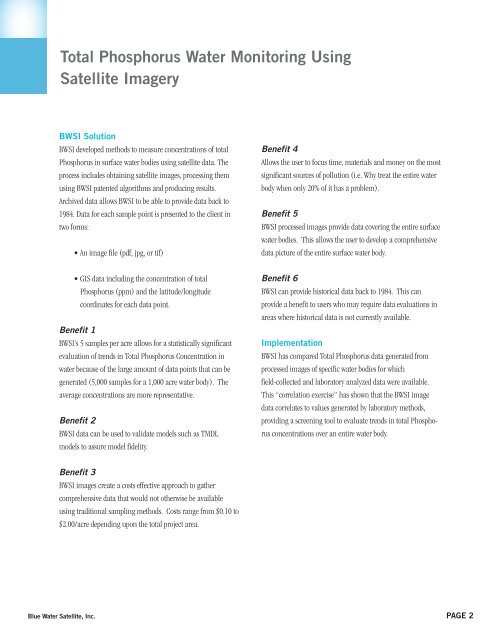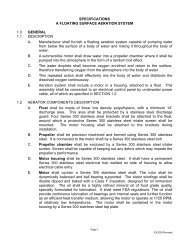How Satellite Images Provide Total Phosphorus Monitoring White ...
How Satellite Images Provide Total Phosphorus Monitoring White ...
How Satellite Images Provide Total Phosphorus Monitoring White ...
You also want an ePaper? Increase the reach of your titles
YUMPU automatically turns print PDFs into web optimized ePapers that Google loves.
<strong>Total</strong> <strong>Phosphorus</strong> Water <strong>Monitoring</strong> Using<strong>Satellite</strong> ImageryBWSI SolutionBWSI developed methods to measure concentrations of total<strong>Phosphorus</strong> in surface water bodies using satellite data. Theprocess includes obtaining satellite images, processing themusing BWSI patented algorithms and producing results.Archived data allows BWSI to be able to provide data back to1984. Data for each sample point is presented to the client intwo forms:• An image file (pdf, jpg, or tif)Benefit 4Allows the user to focus time, materials and money on the mostsignificant sources of pollution (i.e. Why treat the entire waterbody when only 20% of it has a problem).Benefit 5BWSI processed images provide data covering the entire surfacewater bodies. This allows the user to develop a comprehensivedata picture of the entire surface water body.• GIS data including the concentration of total<strong>Phosphorus</strong> (ppm) and the latitude/longitudecoordinates for each data point.Benefit 1BWSI’s 5 samples per acre allows for a statistically significantevaluation of trends in <strong>Total</strong> <strong>Phosphorus</strong> Concentration inwater because of the large amount of data points that can begenerated (5,000 samples for a 1,000 acre water body). Theaverage concentrations are more representative.Benefit 2BWSI data can be used to validate models such as TMDLmodels to assure model fidelity.Benefit 6BWSI can provide historical data back to 1984. This canprovide a benefit to users who may require data evaluations inareas where historical data is not currently available.ImplementationBWSI has compared <strong>Total</strong> <strong>Phosphorus</strong> data generated fromprocessed images of specific water bodies for whichfield-collected and laboratory analyzed data were available.This “correlation exercise” has shown that the BWSI imagedata correlates to values generated by laboratory methods,providing a screening tool to evaluate trends in total <strong>Phosphorus</strong>concentrations over an entire water body.Benefit 3BWSI images create a costs effective approach to gathercomprehensive data that would not otherwise be availableusing traditional sampling methods. Costs range from $0.10 to$2.00/acre depending upon the total project area.Blue Water <strong>Satellite</strong>, Inc.PAGE 2





